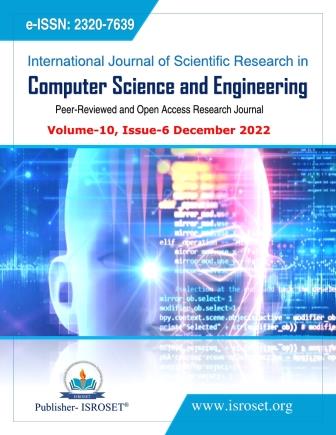Student Grade Prediction by using Machine Learning Methods and Data Analytics Techniques
Keywords:
Student Grade System, Data Analytics, Univariate Linear Regression ModelAbstract
In the world of an open education system, students have the flexibility to learn anything with ease as the learning content is easily available. This can make the student rather confident as well as careless at the same time. Therefore, it becomes challenging to predict the performance of the student beforehand. In this research, an attempt is made to improve the students’ situations by predicting their performance in advance. This is done by applying the univariate linear regression model. This would help the students improve their performance based on predicted grades and enable teachers to identify those who need assistance. The Main objective of this paper is to implement a simple algorithmic model that predicts the score an individual student that he/she will get at the end of the year. “G3” or the final grade is our label (output) and the rest of the columns will be our features (inputs).
References
P. Cortez and A. Silva. Using Data Mining to Predict Secondary School Student Performance. In A. Brito and J. Teixeira Eds., Proceedings of 5th FUture BUsiness TEChnology Conference (FUBUTEC 2008) EUROSIS, ISBN 978-9077381-39-7. Porto, Portugal, pp.5-12, April 2008.
W.-K. Chen, Linear Networks and Systems (Book style). Belmont, CA: Wadsworth, pp.123–135, 1993.
J. Clerk Maxwell, A Treatise on Electricity and Magnetism, 3rd ed., Oxford: Clarendon, Vol.2, pp.68–73, 1892.
Kotsiantis S.; Pierrakeas C.; and Pintelas P., 2004. Predicting Students’ Performance in Distance Learning Using Machine Learning Techniques. Applied Artificial Intelligence (AAI), 18, no. 5, 411–426B. Smith, “An approach to graphs of linear forms (Unpublished work style),” unpublished, 2004.
Pritchard M. and Wilson S., 2003. Using Emotional and Social Factors To Predict Student Success. Journal of College Student Development, 44 no 1, 18-28, 2003.
Merceron, A. and Yacef, K., 2010. Measuring correlation of strong symmetric association rules in educational data. C. Romero, S. Ventura, M. Pechenizkiy, & RSJ d. Baker (Eds.), Handbook of educational data mining, pp.245-256, 2010.
Heemskerk, I., ten Dam, G., Volman, M. and Admiraal, W., 2009. Gender inclusiveness in educational technology and learning experiences of girls and boys. Journal of Research on Technology in Education, Vol.41, Issue.3, pp.253-276, 2009.
Rohit Raja, Tilendra Shishir Sinha, Raj Kumar Patra and Shrikant Tiwari(2018), Physiological Trait Based Biometrical Authentication of Human-Face Using LGXP and ANN Techniques, Int. J. of Information and Computer Security, (Scopus Index), Vol.10, Nos. 2/3, pp.303- 320, 2018.
Rohit Raja, Tilendra Shishir Sinha, Ravi Prakash Dubey (2015), An Empirical Analysis for Detection of Occlusion for face image parallel to the surface plain using Soft-Computing technique, Mats Journal of Engineering & Vol.I (1), pp. 1-6Technology, ISSN 2394-0549. Vol.1, Issue.2, pp.95-102, 2015.
M. Mayilvaganan, D. Kalpanadevi, Comparison of classification techniques for predicting the performance of students academic environment, in: Communication and Network Technologies (ICCNT), International Conference on, IEEE, pp.113–118, 2014.
]K. F. Li, D. Rusk, F. Song, Predicting student academic performance, in: Complex, Intelligent, and Software Intensive Systems (CISIS), 2013 Seventh International Conference on, IEEE, pp.27–33, 2013.
M. Mayilvaganan, D. Kalpanadevi, Comparison of classification techniques for predicting the performance of students academic environment, in: Communication and Network Technologies (ICCNT), 2014 International Conference on, IEEE, pp.113–118, 2014.
W. Ham¨ al¨ ainen, ¨ M. Vinni, Comparison of machine learning methods for intelligent tutoring systems, in: Intelligent Tutoring Systems, Springer, pp.525–534, 2006.
Z. Ibrahim, D. Rusli, Predicting students academic performance: comparing artificial neural network, decision tree and linear regression, in: 21st Annual SAS Malaysia Forum, 5th September, 2007.
T. Wang, A. Mitrovic, Using neural networks to predict student’s performance, in: Computers in Education, 2002. Proceedings. International Conference on, IEEE, pp. 969–973, 2002.
M. Mayilvaganan, D. Kalpanadevi, Comparison of classification techniques for predicting the performance of students academic environment, in: Communication and Network Technologies (ICCNT), International Conference on, IEEE, pp.113–118, 2014.
S. T. Jishan, R. I. Rashu, N. Haque, R. M. Rahman, Improving accuracy of students final grade prediction model using optimal equal width binning and synthetic minority over-sampling technique, Decision Analytics 2 (1), pp.1–25, 2015.
C. Romero, M.-I. Lopez, ´ J.-M. Luna, S. Ventura, Predicting students’ final performance from participation in on-line discussion forums, Computers & Education 68, pp.458–472, 2013.
Bindushree V., Rashmi G.R., Uma H.R., “Analysis of Text Recognition with Data Mining Techniques,” International Journal of Scientific Research in Computer Science and Engineering, Vol.7, Issue.6, pp.40-42, 2019.
Manimaran R. and Vanitha M, “An Efficient Study on Usage of Data Mining Techniques for Predicting Diabetes”, International Journal of Advanced Research Trends in Engineering and Technology (IJARTET), ISSN: 2394-3785, Vol.3, Issue.20, pp.268-272, 2016.
Downloads
Published
How to Cite
Issue
Section
License

This work is licensed under a Creative Commons Attribution 4.0 International License.
Authors contributing to this journal agree to publish their articles under the Creative Commons Attribution 4.0 International License, allowing third parties to share their work (copy, distribute, transmit) and to adapt it, under the condition that the authors are given credit and that in the event of reuse or distribution, the terms of this license are made clear.







